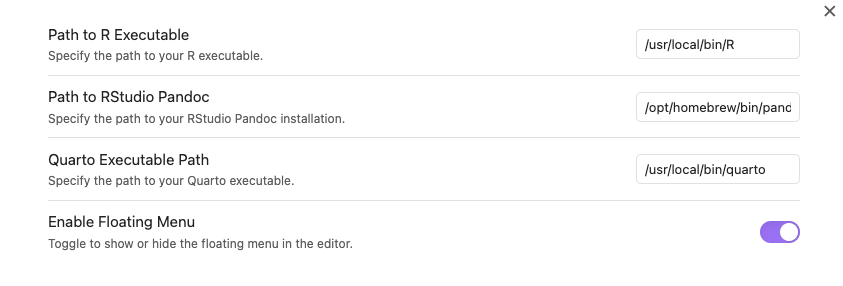Setup & User Guide
What is Ridian?
Ridian is a community plugin for Obsidian, arguably the very best markdown based note taking app. Ridian provides tools needed to run
Install the plugin:
You can Install the plugin from the Obsidian plugin repository: https://obsidian.md/plugins?search=Ridian#
R requirements for the plugin:
In R you must install the packages: languageserver, evaluate, jsonlite & htmlwidgets packages for the plugin to work.
Setup the plugin:
you have to set up paths to R to use the plugin ( and optionally Quarto & pandoc to get more functionality):

How do you find the path to R? open up R and run: file.path(R.home("bin"), "R") or on Windows try file.path(R.home("bin"), "R.exe").
Similarly, you can use the following code in R to find oyur quarto and pandoc install:
quarto::quarto_path()
rmarkdown::find_pandoc()If you have installed R studio pandoc and quarto should be available, if not you can find those software tools here:
Code chunk fence options
Use R chunks with unfenced first line to comply with Obsidian markdown: ```r if you want r specific code highlighting. If you render to quarto using Ridian ,the fences will automatically be changed to: ```{r}. The quarto style fences will work, but they wont get code highlighting, Obsidian won’t recognize the code language properly.
The preferred code chunk style in Ridian is therefore:
```r
1 + 1
```Code output management
in Ridian code chunks MUST have a label, because output is presented as a custom callout type (> [!OUTPUT]). The code finds an existing output callout based on the label,if you change the label, you’ll get new output. If you forget a label, one will be generated.
If you’d execute the code below
```r
#| label: sum123
1 + 1
```it would generate a labeled callout:
[!OUTPUT]+ {#output-sum123}
2